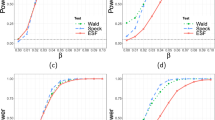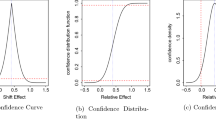Abstract
Consider a semiparametric regression model \(Y=Z\beta +m(X)+\epsilon\), with Y being the response variable, X and Z being the covariates, \(\beta\) the unknown parameter, \(m(\cdot )\) an unknown function preferably a non-linear one, and \(\epsilon\) the random error. In this article, our objective is to test the independence between X and \(\epsilon\) only, given the assumption of no relationship between Z and \(\epsilon\). Using the concept of Robinson’s (Econometrica 56:931–954, 1988) technique of \(\beta\) estimation at the first stage and then considering a transformed nonparametric model, test statistic is formed on the function of induced order statistics of Y. Thereafter constructing Le Cam’s contiguous alternatives, the local powers of the proposed rank-based test statistic as well as power performances of some other relevant statistics are discussed. Further, in reference to the finite sample simulation study, the power performance of newly introduced test is investigated. Finally, for a real biological data the practicability of the proposed test technique under the setting of semiparametric regression model is judged.



Similar content being viewed by others
References
Andrews DW, Schafgans MA (1996) Semiparametric estimation of a sample selection model. Cowles Foundation Discussion Papers
Bairamov I, Berred A, Stepanov A (2010) Limit results for ordered uniform spacings. Stat Pap 51(1):227–240
Bergsma W, Dassios A (2014) A consistent test of independence based on a sign covariance related to Kendall’s tau. Bernoulli 20:1006–1028
Bickel PJ, Freedman DA (1981) Some asymptotic theory for the bootstrap. Ann Stat 9:1196–1217
Blum JR, Kiefer J, Rosenblatt M (1961) Distribution free tests of independence based on the sample distribution function. Ann Math Stat 32:485–498
Brown LD, Levine M, Wang L (2016) A semiparametric multivariate partially linear model: a difference approach. J Stat Plan Inference 178:99–111
Das S, Maiti SI, Halder S (2022) An extended approach to test of independence between error and covariates under nonparametric regression model. Thailand Stat. https://ph02.tci-thaijo.org/index.php/thaistat/inpress
Dhar SS, Dassios A, Bergsma W (2018) Testing independence of covariates and errors in nonparametric regression. Scand J Stat 45:421–443
Einmahl JHJ, Van Keilegom I (2008) Tests for independence in nonparametric regression. Stat Sin 18:601–615
Engle RF, Granger CW, Rice J, Weiss A (1986) Semiparametric estimates of the relation between weather and electricity sales. J Am Stat Assoc 81(394):310–320
Erem A, Bayramoglu I (2017) Exact and asymptotic distributions of exceedance statistics for bivariate random sequences. Stat Probab Lett 125(C):181–188
Gregory GG (1977) Large sample theory for U statistics and test of fit. Ann Stat 5(1):110–123
Hajek J, Sidak Z, Sen PK (1999) Theory of rank tests. Academic Press, London
Hlavka Z, Huskova M, Meintanis SG (2011) Tests for independence in non-parametric heteroscedastic regression models. J Multivar Anal 102:816–827
Hoeffding W (1948) A non-parametric test of independence. Ann Math Stat 19:546–557
Hosking JRM (1990) L-moments: analysis and estimation of distributions using linear combinations of order statistics. J R Stat Soc B 52:105–124
Le Cam L (1960) Local asymptotically normal families of distributions. Univ Calif Publ Statist 3:37–98
Lee AJ (1990) U-statistics: theory and practice. Marcel Dekker, New York
Li Q (1996) On the root-n-consistent semiparametric estimation of partially linear models. Econ Lett 51(3):277–285
Lin X, Carroll RJ (2001) Semiparametric regression for clustered data using generalized estimating equations. J Am Stat Assoc 96(455):1045–1056
Liu Z, Liu Z, Lu X, Lu X (1997) Root-n-consistent semiparametric estimation of partially linear models based on k-nn method. Economet Rev 16(4):411–420
Nadaraya EA (1964) On non-parametric estimates of density functions and regression curves. Stat Sin 15:635–644
Neumeyer N (2009) Testing independence in nonparametric regression. J Multivar Anal 100:1551–1566
Robinson PM (1988) Root-N-consistent semiparametric regression. Econometrica 56:931–954
Serfling RJ (1980) Approximation theorems of mathematical statistics. Wiley, New York
Shiller RJ, Fischer S, Friedman BM (1984) Stock prices and social dynamics. Brook Pap Econ Act 2:457–510
Van der Vaart A (2002) The statistical work of Lucien Le Cam. Ann Stat 30(3):631–682
Acknowledgements
Both authors are grateful to the anonymous referee for his valuable suggestions and thorough inspection over the manuscript. The corresponding author is financially supported by Core Research Project Grant (EMR/2017/005421) from Science and Engineering Research Board, Department of Science and Technology, Govt. of India.
Author information
Authors and Affiliations
Corresponding author
Ethics declarations
Conflict of interest
We certify that there is no actual or potential conflict of interest in relation to this article.
Additional information
Publisher's Note
Springer Nature remains neutral with regard to jurisdictional claims in published maps and institutional affiliations.
Appendix
Appendix
1.1 Table Showing Power of Different Test Statistics for Different \(\gamma\)’s
1.2 Proof of Theorem 1
The quantity \(\log L_n\) can be expanded as follows.
Now, using the Taylor expansion of \(\log (1+x)\), \(x>-1\), and WLLN, one can further derive \(\log L_n\) as
Then,
Define a sequence of random variables \(W_n\) as \(\displaystyle {\sum _{i=1}^{n} \frac{\gamma }{\sqrt{n}}\left( \frac{k_{X,\epsilon }(x_i,e_i)}{f_{X,\epsilon }(x_i,e_i)}-1\right) }\). With the help of Lindeberg’s condition, the asymptotic distribution of \(W_n\) is developed as \(\frac{W_n-E(W_n)}{\sqrt{Var(W_n)}}\overset{L}{\longrightarrow }\,\,N(0,1)\) under \(H_0\), where \(\displaystyle {E_{H_0}(W_n)=\sum _{i=1}^{n} \frac{\gamma }{\sqrt{n}} E_{H_0} \left( \frac{k_{X,\epsilon }(x_i,e_i)}{f_{X,\epsilon }(x_i,e_i)}-1\right) =0}\) and
\(\displaystyle {Var_{H_0}(W_n)=\frac{\gamma ^2}{n}\sum _{i=1}^{n} E_{H_0} \left( \frac{k_{X,\epsilon }(x_i,e_i)}{f_{X,\epsilon }(x_i,e_i)}-1\right) ^{2}=\gamma ^{2}E_{H_0}\left( \frac{k_{X,\epsilon }}{f_{X,\epsilon }}-1\right) ^2}\).
Hence it can be stated that under \(H_0\), \(W_n\overset{L}{\longrightarrow } N\left( 0,\gamma ^{2}E_{H_0}\left( \frac{k_{X,\epsilon }}{f_{X,\epsilon }}-1\right) ^2\right)\).
Another sequence of random variables \(\displaystyle {V_n=\frac{\gamma ^{2}}{2n} \sum _{i=1}^{n} \left( \frac{k_{X,\epsilon }(x_i,e_i)}{f_{X,\epsilon }(x_i,e_i)}-1\right) ^2}\) weakly converges to \(\frac{\gamma ^{2}}{2}E_{H_0}\left( \frac{k_{X,\epsilon }}{f_{X,\epsilon }}-1\right) ^2\). So, \(\log L_{n}-W_{n}+V_{n}=o_p(1)\), and Slutsky’s theorem further ensures that the limiting distribution of the sequence of random variables \(M_n=W_n-V_n\) converges to a random variable M such that
Summing up all the facts one can conclude that \(\log L_{n}-M_{n}=o_p(1)\), i.e. \(\log L_{n}\) has the limiting distribution which is identical with the limiting distribution of \(M_{n}\), i.e. \(N(-\frac{1}{2}\sigma ,\sigma )\) where \(\sigma =\gamma ^2 E_{H_0}\left( \frac{k}{f}-1\right) ^{2}\). Thereafter, the Corollary 1 of Lemma 1 is sufficient to establish the fact that \(H_n\) is a contiguous sequence of alternatives due to asymptotic normality of \(\log L_{n}\). Notationally one can express \(F_{X,\epsilon }\triangleleft F_{n;X,\epsilon }\).
1.3 Proof of Theorem 9
-
(i)
The kernel of \(T_{n,1}\) is \(sign\{(X_{(1)}-X_{(2)})(Y^{*(2)}_{(1)}-Y^{*(2)}_{(2)})\}=f((X_{(1)},Y^{*(2)}_{(1)}),(X_{(2)},Y^{*(2)}_{(2)}))\), say.
Define,
$$\begin{aligned} f_{1}(x,y)= & \; {} E[f((X_{(1)},Y^{*(2)}_{(1)}),(X_{(2)},Y^{*(2)}_{(2)}))|X_{(1)}=x,Y^{*(2)}_{(1)}=y] \\= & \; {} E[sign\{(X_{(1)}-X_{(2)})(Y^{*(2)}_{(1)}-Y^{*(2)}_{(2)})\}|X_{(1)}=x,Y^{*(2)}_{(1)}=y] \\= & \; {} 2P[(X_{(1)}-X_{(2)})(Y^{*(2)}_{(1)}-Y^{*(2)}_{(2)})>0|X_{(1)}=x,Y^{*(2)}_{(1)}=y]-1. \end{aligned}$$Now, \(E_{(X_{(1)},Y^{*(2)}_{(1)})}[f_{1}(X_{(1)},Y^{*(2)}_{(1)})]= E_{(X_{(1)},Y^{*(2)}_{(1)}),(X_{(2)},Y^{*(2)}_{(2)})}[f((X_{(1)},Y^{*(2)}_{(1)}),(X_{(2)},Y^{*(2)}_{(2)}))]=0\) under \(H_0\). Then, \(\sigma ^{2}_{1} = Var[f_{1}(X_{(1)},Y^{*(2)}_{(1)})]=E[f^{2}_{1}(X_{(1)},Y^{*(2)}_{(1)})]\), where \(Y^{*(2)}\) has the same distribution function of \(\epsilon ^{*(2)}\) as \(H^{*}_{\epsilon }\) in approximate sense.
Therefore, it is easily seen that \(\sigma ^{2}_1>0\) in general; \(\sigma ^{2}_{1}=0\) if the samples are either all concordant or all discordant, but this case is not considered here. Hence, by the definition of order of degeneracy of a kernel, one can conclude that f has order of degeneracy 0 as \(\sigma ^{2}_{0}=0<\sigma ^{2}_{1}\).
-
(ii)
The variance of \(T_{n,1}\) can be approximated as \(\frac{4\sigma ^{2}_1}{n}\) as in Theorem 5(iii) for large n, and that converges to 0 as \(n\rightarrow \infty\). Again, \(E[sign\{(X_{(i)}-X_{(j)})(Y^{*(2)}_{(i)}-Y^{*(2)}_{(j)})\}]=0\) \(\forall\) \(1\le i<j\le n\) under \(H_0\) as \(P[(X_{(i)}-X_{(j)})(Y^{*(2)}_{(i)}-Y^{*(2)}_{(j)})>0]=P[(X_{(i)}-X_{(j)})(Y^{*(2)}_{(i)}-Y^{*(2)}_{(j)})<0]\) when X is independent to \(Y^*\). Together they imply that \(T_{n,1}\) converges to 0 in probability.
-
(iii)
A straightforward application of Theorem 6 is enough to prove on the asymptotic distribution of \(\sqrt{n}(T_{n,1}-E(T_{n,1}))\) under \(H_0\).
-
(iv)
As a consequence of Le Cam’s third lemma (Van der Vaart 2002; Dhar et al. 2018), the limiting distribution of \((\sqrt{n}(T_{n,1}-E(T_{n,1})), \log L_{n})\) converges to \(N_{2} \left( \begin{pmatrix} 0 \\ -\frac{\sigma }{2} \end{pmatrix}, \begin{pmatrix} 4\sigma ^{2}_{1} &{} \tau \\ \tau &{} \sigma \end{pmatrix} \right) ,\,\,\sigma >0\) under \(H_0\), which further implies \(\sqrt{n}(T_{n,1}-E(T_{n,1}))\overset{L}{\longrightarrow } N(0+\tau , 4\sigma _1^{2})\equiv N(\tau , 4\sigma _1^{2})\) under \(H_n\). We have already computed \(\sigma ^{2}_1\) and it is sufficient to show that the expression of \(\tau\) is identical with \(\mu _1\). Note that
$$\begin{aligned} \tau= & \; {} \displaystyle {\lim _{n\rightarrow \infty } cov_{H_0}(\sqrt{n}(T_{n,1}-E(T_{n,1})),\log L_{n})} \\= & \; {} \displaystyle {\lim _{n\rightarrow \infty } cov_{H_0}(\sqrt{n}(T_{n,1}-E(T_{n,1})), \frac{\gamma }{\sqrt{n}} \sum _{i=1}^{n} \left( \frac{k_{X,\epsilon }(x_i,e_i)}{f_{X,\epsilon }(x_i,e_i)}-1\right) -\frac{\gamma ^{2}}{2n} \sum _{i=1}^{n} \left( \frac{k_{X,\epsilon }(x_i,e_i)}{f_{X,\epsilon }(x_i,e_i)}-1\right) ^2+O_{P}(n^{-1/2}))} \\= & \; {} \displaystyle {\lim _{n\rightarrow \infty } E_{H_0} \left[ (T_{n,1}-E(T_{n,1}))\cdot \gamma \sum _{i=1}^{n} \left( \frac{k_{X,\epsilon }(x_i,e_i)}{f_{X,\epsilon }(x_i,e_i)}-1\right) \right] }, \end{aligned}$$which can be further simplified to
$$\begin{aligned} \displaystyle {2\gamma \int _{-\infty }^{\infty } \int _{-\infty }^{\infty } [2\int _{-\infty }^{x} \int _{-\infty }^{y} dG_X(u)dH^{*}_{\epsilon }(v)+ 2\int _{x}^{\infty } \int _{y}^{\infty } dG_X(u) dH^{*}_{\epsilon }(v)-1]dK_{X,\epsilon }(x,y)}. \end{aligned}$$Hence the proof.
1.4 Proof of Theorem 10
-
(i)
The kernel of \(T_{n,2}\) as in (3.3) can be further determined as
$$\begin{aligned}&g((X_{(1)},Y_{(1)}^{*(2)}),(X_{(2)},Y_{(2)}^{*(2)}),(X_{(3)},Y_{(3)}^{*(2)}),(X_{(4)},Y_{(4)}^{*(2)})),\,say \\&\quad =2I(|X_{(1)}-X_{(2)}|+|X_{(3)}-X_{(4)}|-|X_{(1)}-X_{(3)}|-|X_{(2)}-X_{(4)}|>0, \\&\quad |Y_{(1)}^{*(2)}-Y_{(2)}^{*(2)}|+|Y_{(3)}^{*(2)}-Y_{(4)}^{*(2)}|-|Y_{(1)}^{*(2)}-Y_{(3)}^{*(2)}|-|Y_{(2)}^{*(2)}-Y_{(4)}^{*(2)}|>0)+ \\&\quad 2I(|X_{(1)}-X_{(2)}|+|X_{(3)}-X_{(4)}|-|X_{(1)}-X_{(3)}|-|X_{(2)}-X_{(4)}|<0, \\&\quad |Y_{(1)}^{*(2)}-Y_{(2)}^{*(2)}|+|Y_{(3)}^{*(2)}-Y_{(4)}^{*(2)}|-|Y_{(1)}^{*(2)}-Y_{(3)}^{*(2)}|-|Y_{(2)}^{*(2)}-Y_{(4)}^{*(2)}|<0)-1 \\&\quad = 2P(|Y_{(1)}^{*(2)}-Y_{(2)}^{*(2)}|+|Y_{(3)}^{*(2)}-Y_{(4)}^{*(2)}|-|Y_{(1)}^{*(2)}-Y_{(3)}^{*(2)}|-|Y_{(2)}^{*(2)}-Y_{(4)}^{*(2)}|<0)-1. \end{aligned}$$\(I(\cdot )\) being an indicator function. Define, for \(c=0,\ldots ,4\), \(g_c((x_{(1)},y_{(1)}^{*(2)}),\ldots ,(x_{(c)},y_{(c)}^{*(2)}))=E[g((x_{(1)},y_{(1)}^{*(2)}),\ldots ,(x_{(c)},y_{(c)}^{*(2)}),(X_{(c+1)},Y_{(c+1)}^{*(2)}),\ldots ,(X_{(4)},Y_{(4)}^{*(2)}))]\) and, \(\sigma ^{2}_c = Var[g_c((X_{(1)},Y_{(1)}^{*(2)}),\ldots ,(X_{(c)},Y_{(c)}^{*(2)}))]\). Next, based upon inequalities \(|Y_{(1)}^{*(2)}-Y_{(3)}^{*(2)}|\le |Y_{(1)}^{*(2)}-Y_{(2)}^{*(2)}|+|Y_{(2)}^{*(2)}-Y_{(3)}^{*(2)}|\) and \(|Y_{(2)}^{*(2)}-Y_{(4)}^{*(2)}|\le |Y_{(2)}^{*(2)}-Y_{(3)}^{*(2)}|+|Y_{(3)}^{*(2)}-Y_{(4)}^{*(2)}|\), one can finally derive \(P(Y_{(2)}^{*(2)}>Y_{(3)}^{*(2)},Y_{(1)}^{*(2)}>Y_{(4)}^{*(2)})\) as
$$\begin{aligned} P(Y_{(2)}^{*(2)}>Y_{(3)}^{*(2)},Y_{(1)}^{*(2)}>Y_{(4)}^{*(2)}, Y_{(3)}^{*(2)}>Y_{(1)}^{*(2)})+P(Y_{(2)}^{*(2)}>Y_{(3)}^{*(2)},Y_{(1)}^{*(2)}>Y_{(4)}^{*(2)},Y_{(3)}^{*(2)}\le Y_{(1)}^{*(2)})=\frac{1}{4!}\times 6=\frac{1}{4}. \end{aligned}$$Similarly, \(P(Y_{(2)}^{*(2)}>Y_{(3)}^{*(2)},Y_{(1)}^{*(2)}\le Y_{(4)}^{*(2)})=\frac{1}{4}\). Then, \(P(Y_{(2)}^{*(2)}<Y_{(3)}^{*(2)})=\frac{1}{2}=P(Y_{(2)}^{*(2)}>Y_{(3)}^{*(2)})\), implying that \(2P(|Y_{(1)}^{*(2)}-Y_{(2)}^{*(2)}|+|Y_{(3)}^{*(2)}-Y_{(4)}^{*(2)}|-|Y_{(1)}^{*(2)}-Y_{(3)}^{*(2)}|-|Y_{(2)}^{*(2)}-Y_{(4)}^{*(2)}|<0)=2\min \{\frac{1}{2},\frac{1}{2}\}=1\). Hence, \(E[g((X_{(1)},Y_{(1)}^{*(2)}),(X_{(2)},Y_{(2)}^{*(2)}),(X_{(3)},Y_{(3)}^{*(2)}),(X_{(4)},Y_{(4)}^{*(2)}))]=0\), and \(\sigma ^{2}_1\) can be expressed as \(cov[g((X_{(1)},Y_{(1)}^{*(2)}),(X_{(2)},Y_{(2)}^{*(2)}),(X_{(3)},Y_{(3)}^{*(2)}),(X_{(4)},Y_{(4)}^{*(2)}))\) which further becomes \(1+4P[Y_{(2)}^{*(2)}>Y_{(3)}^{*(2)},Y_{(5)}^{*(2)}>Y_{(6)}^{*(2)}]-2P[Y_{(2)}^{*(2)}>Y_{(3)}^{*(2)}]-2P[Y_{(5)}^{*(2)}>Y_{(6)}^{*(2)}]\). For any distinct numbers \(i_1\), \(i_2\), \(i_3\), \(i_4\in \{1,\ldots ,7\}\), \(P[Y_{(i_1)}^{*(2)}>Y_{(i_2)}^{*(2)}>Y_{(i_3)}^{*(2)}>Y_{(i_4)}^{*(2)}]=\frac{6}{4!}=\frac{1}{4}\) and eventually \(P[Y_{(i_1)}^{*(2)}>Y_{(i_2)}^{*(2)}]=\frac{1}{2}\) can be obtained. Then \(\sigma ^{2}_1=1+4\cdot \frac{1}{4}-2\cdot \frac{1}{2}-2\cdot \frac{1}{2}=0\) which implies that the order of degeneracy of the kernel \(g(\cdot )\) is at least 1. Next, we deduce \(\sigma ^{2}_2\) as \(1+4P[Y_{(2)}^{*(2)}>Y_{(3)}^{*(2)},Y_{(2)}^{*(2)}>Y_{(5)}^{*(2)}]-2P[Y_{(2)}^{*(2)}>Y_{(3)}^{*(2)}]-2P[Y_{(2)}^{*(2)}>Y_{(5)}^{*(2)}]\). By the method of combinatorics, one can simplify it as \(4\cdot 5\cdot 6 P[Y_{(2)}^{*(2)}>Y_{(3)}^{*(2)}>Y_{(5)}^{*(2)}>Y_{(6)}^{*(2)}>Y_{(4)}^{*(2)}>Y_{(1)}^{*(2)}]+4\cdot 5\cdot 6 P[Y_{(2)}^{*(2)}>Y_{(5)}^{*(2)}>Y_{(3)}^{*(2)}>Y_{(6)}^{*(2)}>Y_{(4)}^{*(2)}>Y_{(1)}^{*(2)}]=2\times \frac{4\cdot 5\cdot 6}{6!}=\frac{1}{3}\). Ultimately, one can get \(\sigma ^{2}_2=1+4\cdot \frac{1}{3}-2\cdot \frac{1}{2}-2\cdot \frac{1}{2}=\frac{1}{3}>0\), henceforth \(T_{n,2}\) has order of degeneracy 1.
-
(ii)
Using Result 1 by Bairamov et al. (2010), it is easy to verify that \((|X_{(i)}-X_{(j)}|+|X_{(k)}-X_{(l)}|-|X_{(i)}-X_{(k)}|-|X_{(j)}-X_{(l)}|)(|Y^{*(2)}_{(i)}-Y^{*(2)}_{(j)}|+|Y^{*(2)}_{(k)}-Y^{*(2)}_{(l)}|-|Y^{*(2)}_{(i)}-Y^{*(2)}_{(k)}|-|Y^{*(2)}_{(j)}-Y^{*(2)}_{(l)}|)=O_{p}(\frac{\log n}{n}),\,\,\,\forall 1\le i<j<k<l\le n\). Also, the distribution function of \((|\epsilon ^{*(2)}_{(i)}-\epsilon ^{*(2)}_{(j)}|+|\epsilon ^{*(2)}_{(k)}-\epsilon ^{*(2)}_{(l)}|-|\epsilon ^{*(2)}_{(i)}-\epsilon ^{*(2)}_{(k)}|-|\epsilon ^{*(2)}_{(j)}-\epsilon ^{*(2)}_{(l)}|)\) can be derived as \(\displaystyle {\int _{-\infty }^{\infty } \Big \{H^{*}_{\epsilon }\left( v+\frac{t}{2}\right) -H^{*}_{\epsilon }\left( v-\frac{t}{2}\right) \Big \}dH^{*}_{\epsilon }(v)}\), denoted by \(H^{^{*(2)}}_{\epsilon }(t)\), say, for \(t\in {\mathbb {R}}\). A similar argument as done in proof of Theorem 9 can be made that the distribution function of \(\epsilon ^{*(2)}\) is approximately identical with the distribution function of \(Y^{*(2)}\). By Slutsky’s theorem, it is evident that \(a(X_{(i)},X_{(j)},X_{(k)},X_{(l)})a(Y^{*(2)}_{(i)},Y^{*(2)}_{(j)},Y^{*(2)}_{(k)},Y^{*(2)}_{(l)})\) converges to 0 in probability \(\forall\) \(1\le i<j<k<l\le n\), which leads us to conclude that \(T_{n,2}\overset{P}{\longrightarrow } 0\) as \(n\rightarrow \infty\) further.
-
(iii)
Since \(T_{n,2}\) has order of degeneracy 1, following the footstep of Theorem 7, it can be concluded straightaway that \(n(T_{n,2}-E(T_{n,2}))\) weakly approaches towards a non-degenerate random variable of the form \({\sum _{i=1}^{\infty } \lambda _{i}(Z_i^{2}-1)}\) with \(\lambda _i\)’s being eigenvalues associated with l(x, y). The complete proof can be deduced by borrowing the methodologies of Serfling (1980), Lee (1990).
-
(iv)
Theorem 8, originally proposed by Gregory (1977), is required to complete the proof on the form of the limiting law of \(n(T_{n,2}-E(T_{n,2}))\) under \(H_n\).
1.5 Proof of Theorem 11
-
(i)
Similar proof will be carried out as in proving the order of degeneracy of \(T_{n,2}\) to be 1.
-
(ii)
Analogous to the proof of Theorem 10(ii).
-
(iii)
Analogous to the proof of Theorem 10(iii).
-
(iv)
Analogous to the proof of Theorem 10(iv).
Rights and permissions
Springer Nature or its licensor holds exclusive rights to this article under a publishing agreement with the author(s) or other rightsholder(s); author self-archiving of the accepted manuscript version of this article is solely governed by the terms of such publishing agreement and applicable law.
About this article
Cite this article
Das, S., Maiti, S.I. On the Test of Association Between Nonparametric Covariate and Error in Semiparametric Regression Model. J Indian Soc Probab Stat 23, 541–564 (2022). https://doi.org/10.1007/s41096-022-00139-0
Accepted:
Published:
Issue Date:
DOI: https://doi.org/10.1007/s41096-022-00139-0
Keywords
- Kendall’s \(\tau\)
- Measures of association
- Distance covariance
- Asymptotic power
- Contiguous alternative
- Nonparametric regression model
- Semiparametric regression model




